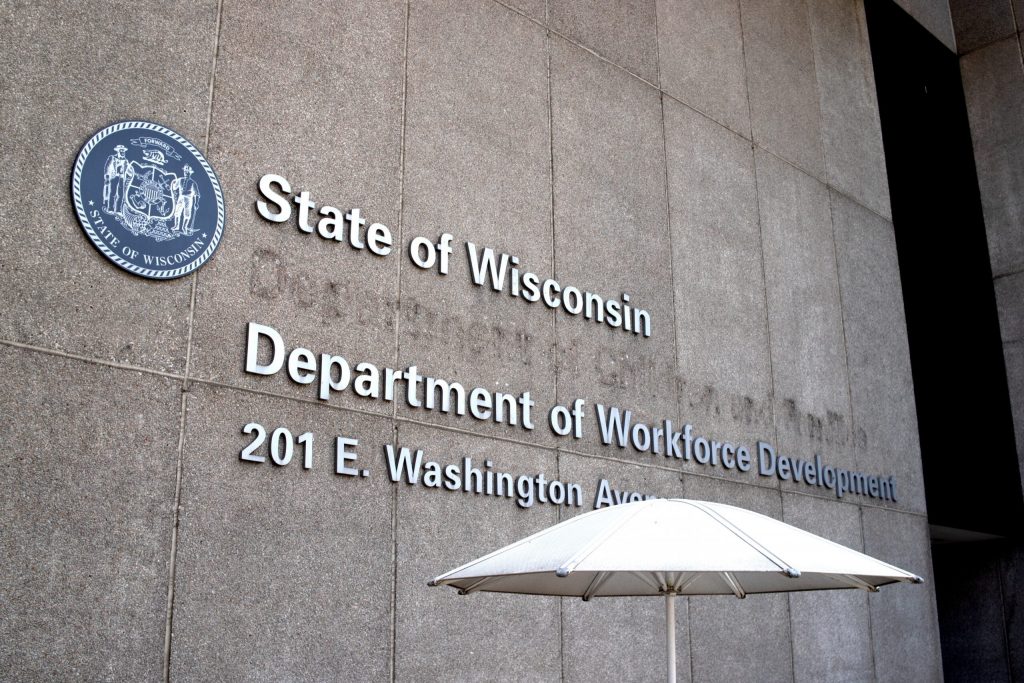Federal Shutdown Cuts Off Funding For State Job Support Programs
Labor statistics also frozen.

Outside the State of Wisconsin Department of Workforce Development building in Downtown Madison. Steven Potter/WPR
The Wisconsin Department of Workforce Development warns that the ongoing federal government shutdown means the state agency isn’t getting federal funding for most of its job support programs.
Approximately 75 percent of the department’s $500 million operating budget comes from federal funds, according to DWD Secretary Amy Pechacek. That money supports career counseling, unemployment administration, apprenticeship programs and other workforce initiatives, she said.
Unless it’s an already approved federal grant award, she said, the department is not getting federal funding right now. For now, the agency is using carryover federal dollars and some state funds to keep operations running, but that money will not last long, she said.
“The majority of the job support programs — working with people with disabilities, unemployment administration, job centers, career counseling — are all federally-funded programs,” Pechacek said on a call with reporters Thursday. “We need the federal government to come together, come up with a funding mechanism and continue to support their obligations to the state.”
On the call, Pechacek discussed how the shutdown affects the state’s workers and economy. The agency held the call in place of its monthly briefing on labor force and unemployment data.
“Because of the dysfunction at the federal level, we do not know when we are going to be able to provide all of you the updated data,” Pechacek said.
DWD officials say the shutdown means the agency cannot release its state-level jobs report. Pechacek said the state report is compiled and shared in conjunction with the U.S. Bureau of Labor Statistics, which has suspended operations and the employees providing employment metrics.
And the Bureau of Labor Statistics information isn’t the only data unavailable to state economists.
“We were missing Census data. We’re missing data from the Bureau of Economic Analysis,” said Scott Hodek, an economist with the Department of Workforce Development. “It’s all of the government data that we end up losing here.”
Hodek said economists are trying to piece things together the best they can, but it’s “pretty difficult to get an accurate picture of what’s happening, the further we get from the last point we had good government data.”
Pechacek added that missing labor force data hurts the state’s economy and job market because employers, policymakers and job seekers rely on that information to make informed decisions about the economy, like whether to expand a business or lay off workers.
“Without that data, employers are putting off important decisions, essentially fumbling around in the dark until Congress can get around to turning back the lights on,” she said.
In addition to missing data, Pechacek said Wisconsin is home to 18,000 federal employees, and DWD estimates around 8,000 “could be impacted during the shutdown.”
She said the state has already processed 30 initial unemployment claims from federal workers.
If furloughed federal workers receive unemployment benefits during the shutdown and then back-pay when the government reopens, Pechacek said they will have to repay the unemployment funds they received. If they are laid off by the federal government and do not receive back-pay for the shutdown, she says they will not repay unemployment benefits.
“It’s sort of a day-to-day ongoing, developing situation that we continue to monitor so that we can best support all workers here in the state of Wisconsin,” she said. “We really need our federal government to return to work so they can restore some predictability and reliability to our economy.”
The shutdown is also impacting temporary seasonal agricultural work visas, or H-2A visas, officials said.
Last year, Wisconsin issued around 3,000 of those visas, Pechacek said. In order to issue them, DWD needs to complete a worker shortage verification that must be certified by the U.S. Department of Labor before federal immigration officials can issue visas.
Pechacek said immigration officials are still issuing visas, but the Department of Labor, or DOL, is essentially shut down and unable to provide the certification component.
“H-2A visas have ceased to be issued,” she said. “They are not being issued now because it needs that component from DOL.”
If the shutdown continues into December or January — the months where DWD sees the highest H-2A visa requests — Wisconsin’s agricultural producers could struggle to get the workers they need, Pechacek said.
“We are off-season now, but as this stalemate continues, it is just incumbent on the federal government to come together to get the government operational,” she said. “The longer this goes, the continued adverse and exponentially worse impacts to our workforce will compound.”
Wisconsin workforce agency warns federal shutdown cuts off most job program funding was originally published by Wisconsin Public Radio.
If you think stories like this are important, become a member of Urban Milwaukee and help support real, independent journalism. Plus you get some cool added benefits.



















